Tang Contemporary Art is pleased to announce the solo exhibition “Narration: Action Poem” by artist Zhang Hui, opening on October 4, 2025, at Tang Contemporary Art Hong Kong, Central space.
This exhibition marks Zhang Hui’s first solo project with Tang Contemporary Art, presenting nine new paintings. Curated by Tang Contemporary Art curator Fiona Lu, the exhibition will remain on view until November 12.
Several years ago, while teaching, Zhang Hui painted from a model. At first, it was merely an exercise in studying form, proportion, structure, and musculature. The model was simply an object. Yet over time, Zhang realized the models were more than that: they had a social identity, they were a living human being. Still, in practice, when drawing a model, the subject is not portrayed as a person but used as a medium for training. Thus, the model’s identity becomes strange—both “a person” and, at the same time, like a plaster cast, a kind of “for-example person.” From this realization, Zhang began broader reflections on shifts in subjects and perspectives throughout art history: from depictions of gods and popes in religious painting, to monarchs, to the emergence of democracy and freedom after the French Revolution of 1789; from looking up at divinity, to gazing upon kings, to the leveled gaze of the Impressionists. Over time, humans shifted from being accessories to gods into objects that could be regarded directly. This historical trajectory inspired Zhang’s understanding of the “for-example person”—at once an object, and a node within a larger sequence.
In his practice, Zhang gathers different types of imagery: from art history, from 3D modeling, from online sources. Much like the “collecting of ancient characters” in Chinese calligraphy, Zhang assembles and strings together these “images” into a “nodal narration.” This narration is not storytelling but a matter of connections and arrangements. The episodes and scenarios often tie back to Zhang’s own experiences. Born in the 1960s, Zhang lived through several critical moments of social transformation in China. His works do not pursue grand narratives, but begin from “the human”—from observation, from questions of humanity. Zhang turns his personal experiences into nodes, extending them into pictorial form. These works inherit the solemnity of figuration while also depicting individuals fragmented and compressed by social structures, transformed into examples of the “for-example person.” We are all, in a sense, such “for-example people,” trained, modified, referenced, even treated as subjects of experiment—like dissected figures. Thus, Zhang incorporates small vignettes into his paintings. These are not portraits of specific individuals, but altered figures. For instance, the gesture of “lying flat” is conveyed through the posture of a chair merging with a body. The “for-example person” exists as an object within a larger scene, subject to transformations by shifting environments and contexts. In the painting Untitled・Fact, for example, a male figure is visibly cut apart, as if marking the division line of the “ordinary citizen.”
This exploration extends into Zhang’s Happy New Year series, represented in this exhibition by three large-scale paintings. Samuel Beckett’s play Oh les beaux jours (translated as Happy Days) has been deeply influential for Zhang. In the play, the protagonist strings together fragments of the characters through memories, using a stream-of-consciousness style that denies chronology, displaces time, and opens broader narrative possibilities. Zhang adopts a similar method in these paintings, selecting a particular moment in a given year—like “that day”—to stand for the experience of an entire year. Structurally, Zhang deliberately imbues these works with the visual quality of greeting cards. Greeting cards symbolize celebration and ritual; they suspend the insistence on realism, shifting instead toward symbolic interpretation. Their flatness gives the artist freedom to weave his images more fluidly.
Often, Zhang’s figures do not bear clear resemblance to real individuals; they function more like “action poems.” Many gestures are drawn from labor or everyday tasks. When holding a tool, the action is specific; once the tool is removed, the gesture becomes abstract—akin to dance. The line between dance and labor is often no more than the absence or presence of an object. Without a concrete reference, actions slip from the literal into the abstract, ready to be recoded and reinterpreted. Actions are not simply poses; they carry the weight of culture and history. For example, American writer Raymond Carver in Popular Mechanics describes a couple fighting over their child, where a single gesture is laden with tension and meaning. Similarly, in Confucian tradition, the dictum “the beginning of propriety lies in the rectitude of body and form” imbues every gesture with cultural and symbolic weight. Bertolt Brecht’s epic theater likewise emphasized the historicity of actions—each gesture arises from a distinct social and class context. Workers, peasants, intellectuals—all bear the imprint of their era in their physical movements. At the same time, if an action loses its predetermined purpose, it becomes an “open action”—uncertain, illogical, yet capable of generating new rhetoric, new relations, and unexpected beauty.
Zhang is especially drawn to such “failed” or “intermediate” gestures—ones without clear cause or purpose, yet capable of generating meaning in the process. These are the actions most closely tied to freedom. They avoid rigid determinacy, instead opening spaces for new cultural possibility. Gesture studies also reveal their temporality: wartime hand signals, for instance, bear heavy cultural and historical weight. Likewise, in China during the 1990s and today, the bodily states and mannerisms of different generations reflect evolving social environments. Even the militarized trimming of trees in French cities embodies the pervasive presence of design and control.
Thus, people are both shaped objects and shaping agents. This tension can be harsh—like in Italo Calvino’s novel, where figures on a battlefield are split in two, bodies incomplete but spirits intertwined. In such parables, we witness humans reconfigured by space while simultaneously generating new social relations. With his brush, Zhang dissects the duality of the “for-example person”: at once an object structured by norms and a subject seeking freedom through action. These “failed” or “intermediate” gestures, free of fixed causality, move beyond the plaster cast as mere training aid. When action surpasses the confines of purpose, we begin to read in bodily language the liveliest essence of humanity: the tension of being molded by society yet forever striving to break free. Each “for-example person,” through action, composes an epic of existence and selfhood.
EXHIBITING WORKS
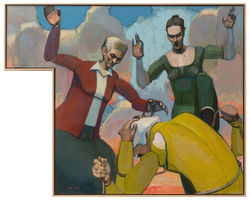 Untitled · Popular MechanicsOil on canvas 150 x 180 cm 2025 | 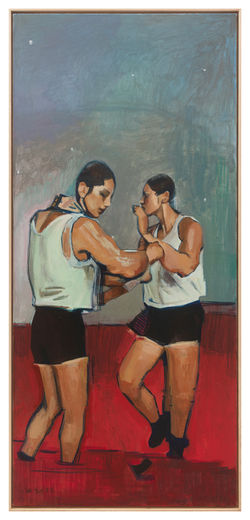 Untitled · FactAcrylic on canvas 216 x 97 cm 2025 | 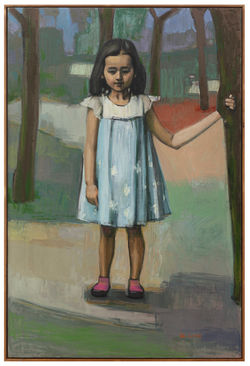 Untitled · Little GirlOil on canvas 162 x 108 cm 2025 |
|---|---|---|
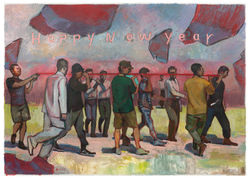 Happy New Year · On the RoadAcrylic on canvas 270 x 380 cm 2025 | 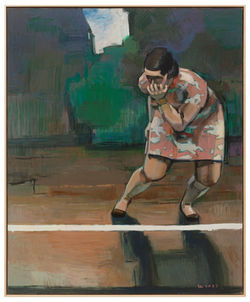 Untitled · ProjectionAcrylic on canvas 200 x 150 cm 2025 |  Happy New Year · Little SeaAcrylic on canvas 270 x 380 cm 2025 |
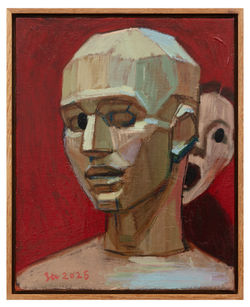 Untitled · BinocularsOil on canvas 50 x 40 cm 2025 |  Untitled · Early SpringAcrylic on canvas 97 x 260 cm 2025 |
Artist
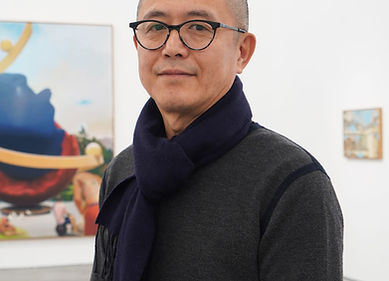.jpg)
Zhang Hui
b. 1967, Heilongjiang, China
Zhang Hui graduated from the Central Academy of Drama in 1991. He was an important member of the Post-Sensibility Group, which was active in the Chinese contemporary art scene from the late 1990s to the early 21st century. He later formed the Assembled Imagery Group in 2004.
In his early explorations, Zhang Hui developed an art practice centred on performance and installation and later ventured into multimedia and live theatre. Since his solo exhibition “Local Area” at Long March Space in 2006, Zhang Hui has focused primarily on exploring painting language. His works subtly incorporate readability and engaging dramatic elements while also reflecting on the authenticity and singularity of people‘s perceptions of reality and striving to expand the structures behind real events and their images.
Zhang Hui explores the blurred boundary between reality and the subconscious, between normality and abnormality. In his recent works, Zhang Hui uses painting as a form of investigation to continuously engage in performative exploration of sustainability and its conceptual relationship with time and space. The subjects of Zhang Hui‘s works range from ordinary habits rooted in everyday life to the exploration of other dimensions—these have become the two main components through which the artist is able to evoke works with dramatic resonance.
Selected solo exhibitions include “Zhang Hui,” MASSIMODECARLO, Beijing, (China, 2024); “Genealogy Study of Artists No. 15 Zhang Hui on Painting,” Start Museum, Shanghai, (China, 2023); “Chinese Eastern Railway: Zhang Hui,” Long March Space, Beijing, (China, 2020); “Zhang Hui 2018,” Long March Space, Beijing, (China, 2018); “Zhang Hui: Zhang Hui,” Long March Space, Beijing, (China, 2016), “Zhang Hui: Plaza,” Long March Space, Beijing, (China, 2014); “Zhang Hui: Groundless,” Long March Space, Beijing, (China, 2012); “Zhang Hui: 21st Floor and a Half,” Long March Space, Beijing, (China, 2009); “Zhang Hui: Ready, Any Time,” Long March Space, Beijing, (China, 2008), “Zhang Hui: Partial Zones,” Long March Space, Beijing, (China, 2006).
He has also participated in numerous group exhibitions in recent years, including “Unnatural Relaxation,” Tang Contemporary Art, Hong Kong, (China, 2024), “Golden: 28th Anniversary Exhibition,” Tang Contemporary Art, Beijing, (China, 2024), “Jiang Han Stars Plan 2021: Young Artists Research Exhibition,” Wuhan Art Museum, Wuhan, (China, 2021), “Duration: Chinese Art in Transformation,” Mingsheng Art Museum, Beijing, (China, 2020), “Meditations in an Emergency,” UCCA Beijing, Beijing, (China, 2020), etc. He was also featured in Art Basel Hong Kong 2019, Beijing Dandai Art Fair 2018.



